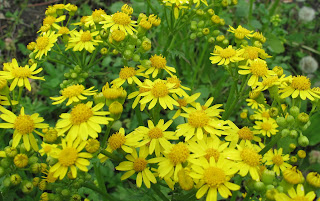There are still over twenty species of wildflowers blooming in the woods, albeit most aren't showy. But because the woodland trails are muddy now and the mosquitoes are thick, you may prefer to stalk roadside flowers.
 |
| Dame's Rocket, Hesperis matronales |
 |
| Various colors of Dame's Rocket |
 |
| Dame's Rocket up close; note foour petals to each flower |
Dame's Rockets are attractive roadside wildflowers, but they the
USDA Plant Database lists as an invasive weed; some states prohibit gardeners from planting it. It has spread throughout the U.S.A., except a few southern states. Dame's Rocket are easy to confuse with Phlox because they tend to be the same size and color, but it has 4 petals and Phlox has five.
 |
| Tansy Ragwort, Senecio jacobea |
The
USDA Plant Database also lists Tansy Ragwort, or "Stinking Willie", as a prohibited, noxious weed in several states. It grows in wet ditches and fields.
 |
| Honeysuckle bush, Lonicera species |
 |
| Honeysuckle up close |
Several Honeysuckle species are invasive in woodlands and old fields.
 |
| Yellow Goatsbeard, Tragopogon pratensis |
 |
| Yellow Goatsbeard up close |
|
Yellow Goatsbeard is another introduced, i.e., non-native, plant, although it tends not to be invasive.
 |
Campion, Silene latifolia
|
Campion (above) and Oxeye Daisy (below) are other introduced plants common to roadsides.
 |
| Oxyeye Daisy, Leucanthemum vulgare |
Not all roadside flowers are introduced or invasive. Common Fleabane is a native plant that frequently grows along roads.
 |
| Common Fleabane, Erigeron phiadelphicus |
Wild Geranium, Virginia Waterleaf. False Solomon/s Seal and Fleabane are all native, woodland plants that sometimes grow along roadsides.
 |
| Wild Geranium, Geranium maculatum |
 |
| Wild Geranium |
 |
| False Solomon's Seal, Maianthemum racemosum |
 |
| Virginia Waterleaf, IHydrophyllum virginianum |

















No comments:
Post a Comment